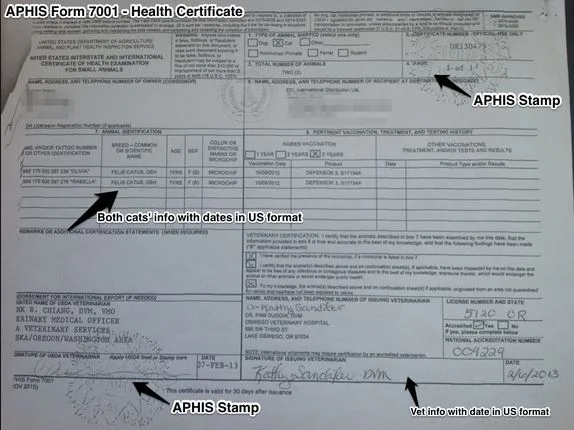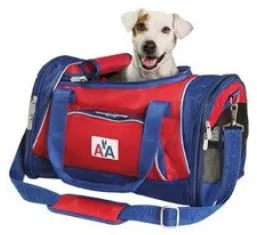Bringing Pets to Ecuador
[Editor’s Note: Pets are important to many expats. The following article is an excerpt from Expats in Ecuador: Life in Cuenca Second Edition by David Morrill and Deke Castleman. It mainly deals with bringing pets with you to Ecuador and was written about a year ago, so some of the facts might’ve changed. We’d appreciate hearing from anyone who’s recently gone through the process as to whether any of the details are different and if so how. And we invite all pet-oriented expats to share any experiences that might be of interest to newcomers and prospective immigrants.]
It’s not difficult to import a pet or pets to Ecuador and many expats do. The biggest challenge for most foreigners is meeting time restrictions for examinations and shots, plus the health certificate that requires legalization by an Ecuadorian consulate. The window of opportunity is narrow, so careful planning is critical.
The process is tedious and has a number of steps, some which can be a bit ambiguous. This is an outline of the steps, taken from the official Ecuadorian document and the experiences of numerous people who’ve gone through the process.
But as always, keep in mind that different people with different animals have different experiences, depending on the local office of the USDA (or the like agency in countries other than the United States), the Ecuadorian consulate nearest you, the airline you fly, the city flown into, the Ecuadorian Customs officials present, the changing regulations and enforcement policies, and the x factors. It’s always best to do your own research.
FORM 7001
Your dog or cat (there might be a few different nuances for multiple animals) must be accompanied by a health certificate, known (in the U.S.) as Aphis Form 7001. This is issued by a licensed veterinarian who’s certified by the United States Department of Agriculture (or, again, a like agency in other countries). Once the vet fills out the form, it must be endorsed by the USDA, then translated into Spanish.
The 7001 health certificate must contain the name and address of the pet owner and the breed  and sex of the animal, and certify that the animal was examined within 10 days of traveling, was healthy with no symptoms of sundry diseases and parasites, has been treated against internal and external parasites at least 21 days prior to traveling, and has been vaccinated at least 21 days prior to traveling against distemper, canine hepatitis, leptospirosis, parvovirus, and parainfluenza.
and sex of the animal, and certify that the animal was examined within 10 days of traveling, was healthy with no symptoms of sundry diseases and parasites, has been treated against internal and external parasites at least 21 days prior to traveling, and has been vaccinated at least 21 days prior to traveling against distemper, canine hepatitis, leptospirosis, parvovirus, and parainfluenza.
In addition, dogs must be vaccinated against rabies at least 60 days prior to traveling.
Now, we’re sure that the vet’s exam has to be conducted no more than 10 days prior to traveling, but we’ve seen it both ways for the vaccinations. The website wording is a bit ambiguous: “The dog must have been vaccinated at least 21 days prior to the date of shipment.” The “at least” is the problem here. We’d understand “at most 21 days prior,” but does “at least” mean more than or less than 21 days? We don’t know. We’ve heard stories about it being interpreted by the vets either way and being accepted by Ecuadorian Customs officials both ways. Same for the 60-day requirement for rabies.
Once you have the form from the vet, you must get it stamped by the USDA in your state. If the office of the USDA that oversees the approved veterinarians in your area isn’t nearby, some overnight mailing of the form may be required.
From there, you present the form to an Ecuadorian consulate for stamping; this is now your animal’s “visa.” You’ll pay $50 per animal. All this must be done no more than 10 days before you leave.
Typically, we’ve heard from some people that USDA Aphis 7001 form doesn’t need to be apostilled, and from others that it does. Apparently, the Ecuadorian consulate in New York thinks it does, but the other Ecuadorian consulates in the U.S. think it doesn’t.
(Here’s what one person had to say about apostilling Form 7001: “When we tried to get the Aphis form apostilled from the Department of State, they told us that they don’t apostille federal documents. However, we were told by the Dept. of State that the way around this is to get an affidavit drawn up by a notary that states that the 7001 form is a true original. This gets attached to the 7001 form and gets notary verification and can then be apostilled. We brought our paperwork to our local EC Consulate in New York and they told us that what we did was correct. We had no problems at Guayaquil airport.) To double check, you can go to www.aphis.usda.gov/regulations/vs/iregs/animals/downloads/ ec_dg.pdf for a two-page pdf of the latest requirements for dogs.
Other than the different shots (rhinotracheitis, panleukopenia, and calicivirus), the procedure for cats is the same as for dogs: examination by a USDA-approved vet, countersigned by the USDA, translated into Spanish, and stamped by an Ecuadorian consulate.
SHIPPING YOUR PET(S) ON THE PLANE
The next step is to coordinate with your airline(s) to ensure that your dog or cat can travel with you. You can also ship animals on their own, but this is more complicated and might require an animal shipping broker, or a very good friend who’s coming to visit you and will chaperone your pet.
An airline can refuse to ship if the flight is fully booked, in which case all the cargo space is reserved for baggage, or if a particular embargo against animals is in force, for example during holidays.
Most cats and some dogs can fly in the cabin if they’re carried in an approved cage or box that fits under the seat in front of you, same as any carry-on luggage (though there are extra pet fees involved; we’ve seen them as high as $150 per animal). We’ve heard that on most airlines, the weight limit for animals in the cabin under the seat is 20 pounds. If the animal doesn’t fit under the seat, some airlines will allow you to buy a seat for it in its cage; others force you to check it as baggage.
All airlines have high-temperature limits (generally 85 degrees) for departure and arrival cities for pets traveling in cargo.
It’s been suggested (in some cases strongly) that you attach a copy of the certificate to the cage if your animal is checked as baggage. It’s always a good idea to have plenty of copies of whatever Immigration/ Customs form(s) you need.
You might consider flying into Quito to avoid the high-temperature complication in Guayaquil. That said, we’ve heard that no Ecuador airlines permit pets inside the cabins of their airplanes. For that reason, you might want to fly into Guayaquil, so you can catch a ride with your animal to Cuenca, instead of flying.
Likewise, we have conflicting information on whether or not you can check your dog or cat at the ticket counter of the Quito or Guayaquil airports as baggage; some people have had to go to the cargo area of the airport to ship their pets. So be sure to check with your local airline to Cuenca.
ENTRY PROCEDURES INTO ECUADOR
Here, all we can say is you’re on your own and good luck. Most people don’t have a problem bringing in their pets, but we’ve heard some stories from people who were sent on wild-goose chases for phantom paperwork, Agrocalidad approvals, and different carrier cages.
We can tell you that unless you’re importing animals as a business, you don’t have to deal with Agrocalidad (the Agriculture Ministry) in Ecuador, or at least you’re not supposed to have to. An exception, of course, is if some Customs official thinks you do.
Ecuador has no quarantine requirement for pets.
HOUSING CONSIDERATIONS
Bringing your pet with you to Cuenca may affect your housing options.
It’s becoming increasingly difficult to find Cuenca rentals that accept pets. Condo associations that at one time had no rules about pets are now restricting them, or forbidding them outright, and some have rules that allow pets for owners, but not renters.
Owners of rental properties, both North American and Ecuadorian, are responding to bad experiences. Some have had to replace carpet, upholstery, and rugs, which cost much more than the pet deposits paid by tenants, according to one property manager, who recently had to pay $700, against a $100 deposit, for repairs to a dog-damaged apartment and, unfortunately, no longer rents to pet owners.
Pet owners planning to buy a condo need to check the association rules before committing to a purchase; we know of several cases in which they didn’t, with expensive consequences. Houses are obviously the best option for pet owners planning to buy.
ADOPTING PETS IN ECUADOR
Both Deke and David have had plenty of animals throughout their lives. David grew up on a farm and Deke has adopted more cats (the last few named Please Dad Please) than he can remember. So we know how attached you can become to pets.
That said, the stray-animal situation throughout Ecuador is dire, compared to North American and Europe, and Cuenca is no exception. If you don’t have a pet to bring with you, or you can leave one at home, you’ll find no shortage of strays — on the street, rescued and languishing in the pound, or being given away by expats who are leaving — that need loving homes.



















